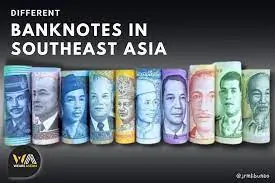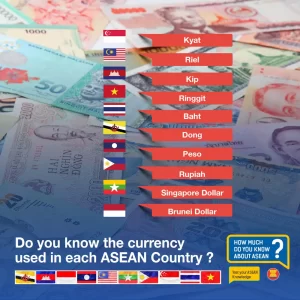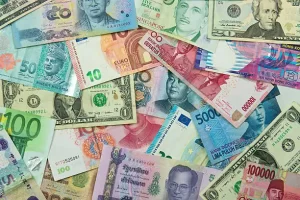Banknotes in Southeast ASIA |Top 10: Intriguing SE Asian Banknotes

Table of Contents
Key Takeaways:
- Rich Cultural Depictions: Banknotes in Southeast ASIA are adorned with intricate designs that reflect the diverse cultures, histories, and natural landscapes of the respective countries.
- Technological Innovations: Modern banknotes from the region incorporate advanced security features to prevent counterfeiting, blending tradition with cutting-edge technology.
- Collectible Value: Many of these banknotes are sought after by collectors worldwide due to their unique designs and limited availability.
- Historical Narratives: Each banknote narrates stories of independence, national heroes, landmarks, and traditional customs, making them more than just a medium of exchange.
Introduction
Banknotes in Southeast ASIA are a canvas for artistic expression and historical storytelling. From the Philippines to Vietnam, each country’s currency captures the essence of its culture and heritage. Let’s explore the top 10 banknotes that stand out for their captivating designs and symbolic representations.
Introducing The 10 Banknotes in Southeast ASIA

- Brunei Dollar (BND)
- Cambodian Riel (KHR)
- Indonesian Rupiah (IDR)
- Lao Kip (LAK)
- Malaysian Ringgit (MYR)
- Myanmar Kyat (MMK)
- Philippine Peso (PHP)
- Singapore Dollar (SGD)
- Thai Baht (THB)
- Vietnamese Dong (VND)
Introduction to Southeast Asian Banknotes
Southeast Asia is a diverse region known for its rich history, culture, and vibrant economies. One of the fascinating aspects of this region is its array of unique banknotes, each reflecting the heritage and identity of its respective country. In this comprehensive guide, we will delve into the intriguing world of Banknotes in Southeast ASIA, exploring the design, history, and significance of various currencies.
Brunei Dollar (BND)
The Brunei Dollar (BND) is the official currency of Brunei Darussalam. Introduced in 1967, the currency showcases the nation’s heritage and natural resources. Brunei’s banknotes feature iconic landmarks, such as Sultan Omar Ali Saifuddin Mosque, and images of local flora and fauna like the proboscis monkey and pitcher plants. The Brunei Dollar maintains a stable exchange rate pegged to the Singapore Dollar.
Origins and History
- The Brunei Dollar (BND) has a notable history tied to Brunei’s sovereignty and economic development.
- Initially introduced in 1967 to replace the Malaya and British Borneo Dollar, it became the official currency of Brunei Darussalam.
Design and Features
- The Brunei Dollar banknotes feature intricate designs that showcase Brunei’s cultural heritage and natural landscapes.
- Notable elements include traditional motifs, local flora and fauna, and landmarks.
Value and Exchange Rate
- The value of the Brunei Dollar fluctuates against major currencies like the US Dollar.
- It is widely accepted within Brunei and holds a stable exchange rate.
Cambodian Riel (KHR)
The Cambodian Riel (KHR) has a complex history intertwined with Cambodia’s political and economic development. Initially introduced during the French colonial period, the Riel has undergone various reforms. Modern Cambodian banknotes highlight national heroes and significant monuments like Angkor Wat. Despite the widespread use of the US dollar, the Riel remains a symbol of Cambodia’s sovereignty.
Historical Background
- The Cambodian Riel (KHR) has a long history, evolving through different regimes and economic phases in Cambodia.
- Initially introduced in 1953, it has since been a symbol of Cambodia’s economic sovereignty.
Design Elements
- Cambodian Riel banknotes typically feature depictions of important historical figures, cultural symbols, and national landmarks.
- The design often reflects Cambodia’s rich artistic traditions.
Monetary Value
- The Riel is used alongside the US Dollar in Cambodia’s dual-currency system.
- Its value is subject to fluctuations based on economic factors and market conditions.
Indonesian Rupiah (IDR)
The Indonesian Rupiah (IDR) is Indonesia’s official currency, reflecting the nation’s vast archipelago and diverse culture. IDR banknotes depict Indonesian landscapes, cultural symbols, and national heroes like Sukarno. Indonesia’s economy has shaped the Rupiah’s value, navigating periods of inflation and stabilization. The Rupiah’s denominations include colorful and intricate designs.
Origins and Development
- The Indonesian Rupiah (IDR) has a complex history dating back to the colonial era.
- It has undergone significant transformations in design and value over the decades.
Cultural Depictions
- IDR banknotes often portray Indonesian heroes, traditional dances, landscapes, and wildlife.
- Each denomination carries unique imagery representing the nation’s diversity.
Economic Significance
- The Rupiah is a vital component of Indonesia’s economy, reflecting the country’s growth and stability.
- Its exchange rate is influenced by domestic and international economic factors.
Lao Kip (LAK)
The Lao Kip (LAK) embodies Laos’ transition to a market economy. Introduced after the Pathet Lao victory, the Kip features socialist themes and national development projects. Banknotes depict Laotian landscapes and traditional motifs. Laos’ economy has influenced the Kip’s value, reflecting efforts to maintain stability amidst regional changes Banknotes in Southeast ASIA.
Historical Evolution
- The Lao Kip (LAK) has evolved alongside Laos’s political and economic changes.
- Its history reflects the country’s journey towards economic independence.
Symbolism in Design
- Lao Kip banknotes feature images of national monuments, ethnic costumes, and traditional ceremonies.
- The design celebrates Lao culture and heritage.
Market Value
- The value of the Lao Kip is relatively stable within Laos but can vary against major currencies.
- It plays a crucial role in everyday transactions across the country.
Malaysian Ringgit (MYR)
The Malaysian Ringgit (MYR) is Malaysia’s currency, known for its security features and distinct designs. MYR banknotes highlight Malaysia’s multiculturalism, showcasing iconic landmarks and traditional arts. Malaysia’s economic growth has influenced the Ringgit’s value, with banknote designs reflecting the nation’s progress and heritage Banknotes in Southeast ASIA.
Rich Heritage
- The Malaysian Ringgit (MYR) is deeply rooted in Malaysia’s multicultural society and economic progress.
- Its inception traces back to the Malaya and British Borneo Dollar era.
Artistic Representations
- Malaysian Ringgit notes showcase iconic landmarks, diverse cultural motifs, and historical figures.
- The design reflects Malaysia’s unity in diversity.
Economic Impact
- The Ringgit’s value is influenced by domestic policies, global economic trends, and geopolitical factors.
- It serves as a symbol of Malaysia’s economic strength and stability.
Myanmar Kyat (MMK)
The Myanmar Kyat (MMK) reflects Myanmar’s tumultuous economic history. The Kyat’s banknotes feature historical figures and landmarks, emphasizing Myanmar’s rich heritage. Economic challenges have impacted the Kyat’s value, leading to various currency reforms. Despite fluctuations, the Kyat remains essential for everyday transactions in Myanmar Banknotes in Southeast ASIA.
Historical Context
- The Myanmar Kyat (MMK) has a complex history intertwined with Myanmar’s political and economic landscape.
- It has undergone various reforms and transformations.
Cultural Imagery
- Kyat banknotes feature depictions of ancient temples, traditional attire, and iconic landscapes.
- The design reflects Myanmar’s rich cultural heritage.
Monetary Value
- The value of the Kyat fluctuates due to internal and external economic factors.
- It remains the primary currency used in Myanmar for daily transactions.
Philippine Peso (PHP)
The Philippine Peso (PHP) represents the Philippines’ colonial past and economic resilience. PHP banknotes feature national heroes, UNESCO World Heritage sites, and indigenous flora and fauna. The Peso’s value has fluctuated, responding to economic trends and global market forces. Filipino banknotes reflect the country’s diverse cultural and natural landscapes Banknotes in Southeast ASIA.
Historical Roots
- The Philippine Peso (PHP) has a colorful history dating back to Spanish colonial times.
- It has adapted to various political changes and economic reforms.
Iconic Designs
- PHP banknotes showcase Filipino national heroes, iconic landscapes, and cultural symbols.
- Each denomination represents different facets of Philippine heritage.
Economic Implications
- The Peso’s value is influenced by domestic economic policies, overseas remittances, and global market conditions.
- It remains a vital currency in the Philippines’ economy and financial markets.
Singapore Dollar (SGD)
The Singapore Dollar (SGD) is a symbol of Singapore’s economic success and stability. SGD Banknotes in Southeast ASIA showcase national icons, such as the Merlion and Marina Bay Sands. Singapore’s monetary policies have contributed to the SGD’s strength and international reputation. The currency’s design reflects Singapore’s modernity and multiculturalism.
Economic Foundations
- The Singapore Dollar (SGD) is a testament to Singapore’s economic success and financial stability.
- It has evolved from the Malayan Dollar era to become a global currency.
Innovative Design
- SGD banknotes feature modern architectural marvels, multicultural symbols, and national icons.
- The design reflects Singapore’s position as a global hub of commerce and innovation Banknotes in Southeast ASIA.
Exchange Rate Dynamics
- The SGD maintains a managed float exchange rate system and is influenced by Singapore’s monetary policies and global economic trends.
- It is widely accepted for international trade and investment.
Thai Baht (THB)
The Thai Baht (THB) reflects Thailand’s rich history and vibrant culture. THB Banknotes in Southeast ASIA depict Thai kings, temples, and traditional ceremonies. Thailand’s economic growth has influenced the Baht’s value, balancing inflation and external factors. The Baht’s unique designs celebrate Thailand’s heritage and spiritual traditions .
Historical Significance
- The Thai Baht (THB) has deep historical roots, reflecting Thailand’s rich heritage and economic development Banknotes in Southeast ASIA.
- It has evolved from traditional forms of currency to modern banknotes.
Cultural Depictions
- Baht banknotes showcase Thai kings, ancient temples, and traditional arts.
- The design embodies Thailand’s cultural pride and national identity.
Economic Role
- The Baht’s value is closely monitored by Thailand’s central bank and influenced by economic indicators.
- It plays a crucial role in facilitating domestic and international transactions Banknotes in Southeast ASIA.
Vietnamese Dong (VND)
The Vietnamese Dong (VND) embodies Vietnam’s journey from conflict to economic development. VND banknotes feature national heroes, cultural symbols, and iconic landscapes like Ha Long Bay. Vietnam’s economic reforms have shaped the Dong’s value, striving for stability and growth. The Dong’s designs reflect Vietnam’s resilience and aspirations Banknotes in Southeast ASIA.
Evolution and Transformation
- The Vietnamese Dong (VND) has undergone significant transformations in design and value.
- It reflects Vietnam’s journey from wartime economies to rapid development Banknotes in Southeast ASIA.
Artistic Representations
- Dong banknotes depict national heroes, natural landscapes, and cultural symbols.
- The design captures Vietnam’s resilience and cultural diversity.
Market Dynamics
- The Dong’s value is managed by Vietnam’s central bank and influenced by economic reforms and global trade.
- It remains an essential currency for Vietnam’s growing economy and international trade Banknotes in Southeast ASIA.
Rates of the Southeast Asian banknotes
| Currency | Code | Conversion Rate (to USD) | Conversion Rate (to EUR) |
|---|---|---|---|
| Brunei Dollar | BND | 1 BND = 0.73 USD | 1 BND = 0.65 EUR |
| Cambodian Riel | KHR | 1 KHR = 0.00025 USD | 1 KHR = 0.00022 EUR |
| Indonesian Rupiah | IDR | 1 IDR = 0.00007 USD | 1 IDR = 0.00006 EUR |
| Lao Kip | LAK | 1 LAK = 0.00010 USD | 1 LAK = 0.00009 EUR |
| Malaysian Ringgit | MYR | 1 MYR = 0.24 USD | 1 MYR = 0.21 EUR |
| Myanmar Kyat | MMK | 1 MMK = 0.00006 USD | 1 MMK = 0.00005 EUR |
| Philippine Peso | PHP | 1 PHP = 0.020 USD | 1 PHP = 0.018 EUR |
| Singapore Dollar | SGD | 1 SGD = 0.74 USD | 1 SGD = 0.66 EUR |
| Thai Baht | THB | 1 THB = 0.030 USD | 1 THB = 0.027 EUR |
| Vietnamese Dong | VND | 1 VND = 0.000043 USD | 1 VND = 0.000038 EUR |

Paper bills (banknotes) of Southeast Asian currencies:
- Brunei Dollar (BND):
- $1, $5, $10, $50, $100
- Cambodian Riel (KHR):
- 100, 200, 500, 1000, 2000, 5000, 10,000, 20,000, 50,000, 100,000
- Indonesian Rupiah (IDR):
- 1000, 2000, 5000, 10,000, 20,000, 50,000, 100,000
- Lao Kip (LAK):
- 500, 1000, 2000, 5000, 10,000, 20,000, 50,000, 100,000, 500,000
- Malaysian Ringgit (MYR):
- RM1, RM5, RM10, RM20, RM50, RM100
- Myanmar Kyat (MMK):
- 50, 100, 200, 500, 1000, 5000, 10,000, 50,000
- Philippine Peso (PHP):
- ₱20, ₱50, ₱100, ₱200, ₱500, ₱1000
- Singapore Dollar (SGD):
- $2, $5, $10, $50, $100, $1000
- Thai Baht (THB):
- 20, 50, 100, 500, 1000
- Vietnamese Dong (VND):
- 1000, 2000, 5000, 10,000, 20,000, 50,000, 100,000, 200,000, 500,000
Each of these Banknotes in Southeast ASIA has its unique design, color scheme, and security features that reflect the respective country’s culture and history.
Pros and cons of Southeast Asian banknotes
| Pros | Cons |
|---|---|
| Rich cultural designs reflecting history | Risk of counterfeiting |
| Symbolic representation of national pride | Exchange rate fluctuations |
| Diverse range of colors and motifs | Limited acceptance outside respective countries |
| Advanced security features for authenticity | Older versions may become obsolete |
| Educational value for learning about cultures | Not universally accepted for international transactions |
Frequently Asked Questions
What security features are incorporated into Southeast Asian banknotes?
Banknotes in Southeast ASIA typically include advanced security features such as holograms, watermarks, security threads, microprinting, and special inks to deter counterfeiting. These features vary by country and are constantly updated to stay ahead of counterfeiters.
Can I use Southeast Asian currencies outside their respective countries?
While some Banknotes in Southeast ASIA currencies like the Singapore Dollar (SGD) and Thai Baht (THB) are accepted in neighboring countries for certain transactions, it’s generally advisable to exchange currency for local use. Major international airports and banks often provide currency exchange services.
What factors influence the value of Southeast Asian currencies?
The value of Banknotes in Southeast ASIA currencies is influenced by various factors including economic stability, inflation rates, interest rates, political stability, trade balances, and global market trends. Exchange rates fluctuate based on these factors and can impact the purchasing power of foreign currencies.
Are older versions of Southeast Asian banknotes still valid?
Most Banknotes in Southeast ASIA countries periodically issue new banknote series with updated designs and security features. However, older versions of banknotes typically remain legal tender for a certain period after new series are introduced. It’s advisable to check with local banks or monetary authorities for specific guidelines.
Where can I learn more about the history and design of Southeast Asian banknotes?
Interested individuals can explore the history and design of Banknotes in Southeast ASIA through museums, central bank websites, numismatic societies, and online resources. These platforms often provide detailed information on the evolution of currency designs, notable features, and the cultural significance of banknotes across the region.
Conclusion
The banknotes of Southeast Asia encapsulate the region’s rich cultural heritage, economic diversity, and historical narratives. These currencies are not merely instruments of trade but tangible expressions of national identity, showcasing unique designs that highlight local landmarks, cultural symbols, and historical figures.
From the intricately detailed notes of Brunei featuring Islamic motifs to the vibrant depictions of Angkorian temples on Cambodian Riel, and from the majestic images of Thai temples on the Thai Baht to the revolutionary themes on Lao Kip, each currency tells a story of resilience, progress, and tradition Banknotes in Southeast ASIA.
The evolution of these banknotes mirrors the economic and political transformations across Banknotes in Southeast ASIA, making them more than monetary units but potent symbols of pride and sovereignty for their respective nations.
You May Also Like:
Advertisement


Nel Wiesenberg is a multifaceted individual known for his diverse career as a technical writer, author, and former professional poker player. His journey in the world of gambling began with a decade-long stint as a professional poker player before transitioning into technical writing. Wiesenberg’s contributions to the gambling community are extensive, having written for various publications over the years.
During his tenure as a professional poker player, Wiesenberg made a significant impact on the industry. He wrote for the original Gambling Times magazine, focusing on keno and poker, showcasing his expertise in these games. Additionally, he had regular columns in publications such as Poker Player and Pan Player +, a magazine catering to Panguingue players. Wiesenberg’s writing extended beyond gambling, with contributions to Dr. Dobb’s Journal, a computer magazine, and A+, a magazine for Apple computer users. His articles also appeared in publications like PC Publishing, Micro Times, Infoworld, and more.